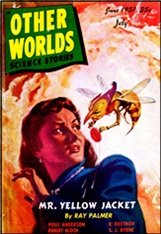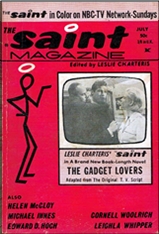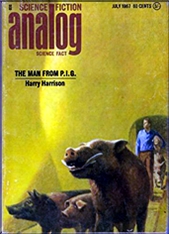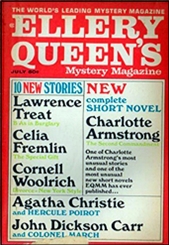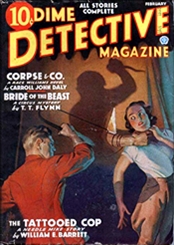REVIEWED BY MIKE TOONEY:
(Give Me That) OLD-TIME DETECTION. Autumn 2023. Issue #64. Editor: Arthur Vidro. Old-Time Detection Special Interest Group of American Mensa, Ltd. 36 pages (including covers). Cover image: The White Elephant Mystery by Ellery Queen, Jr.
If you like detective fiction in any or all of its permutations then you can’t go wrong with Old-Time Detection. The new mingles with the old (which means, in most cases, the classic), leaving plenty for the reader to feast on.
Among the delectations: an interview with a science fiction/fantasy/detective story author; plenty of well-researched background on the creator of the world’s most famous criminal lawyer; the latest (at the time) paperback reprints from the seventies; a review of a collection of stories by the master of noir; a long-lost Dr. Poggioli story and a witty and amusing self-assessment by its author; a view of the “master conjurer” of fair play detection and a look at how he lived; news about the creator of Poirot and Marple and how the current generation is handling (and, in too many cases, mishandling) her works; a glance at how today’s publishers seem to be on some sort of nostalgia kick, which is good news for detec-fic aficionados; words about the undisputed “king of the classical whodunit”; and the editor’s appraisal of a kids’ novel that even adults can enjoy.
In it you will find:
(1) A 1976 interview with Isaac Asimov in EQMM: “I was the comic relief …”
(2) Francis M. Nevins gives us the first part of a multipart essay (2010) about Erle Stanley Gardner; however: “Those wishing to read about Gardner’s Perry Mason character must wait for Part Two.”
(3) Charles Shibuk continues his summary (1973) of the “paperback revolution” in detective/mystery publishing that was occurring half a century ago, focusing on Margery Allingham, Agatha Christie, Amanda Cross, Carter Dickson (otherwise JDC), Erle Stanley Gardner, Frank Gruber, Ngaio Marsh, Bill Pronzini, Rex Stout, Julian Symons, and Charles Williams.
(4) This is followed by Shibuk’s review (1975) of Nightwebs (1971), a collection of Cornell Woolrich’s “mainly unfamiliar works,” edited by Francis M. Nevins, Jr.: “Some of these stories are of extremely high quality, but alas, there is also much dross.”
(5) The issue’s centerpiece story is T. S. Stribling’s “The Mystery of the Paper Wad” (EQMM, 1946), which hasn’t been seen generally since first publication, followed by Stribling’s own “The Autobiography of an Ingenious Author” (1932): “The criminologist smiled at the illusion held by every man that with him all things, crimes and virtues, are possible.”
(6) In “The Full Mandrake” (2023), Rupert Holmes offers us “an appreciation of John Dickson Carr”: “If the classic fair play detective story is the magic act of literature, then John Dickson Carr is forever its master conjurer . . .”
(7) Douglas G. Greene’s assessment (1995) of JDC’s A Graveyard To Let (1949) (“. . . still, the swimming-pool gimmick is beautifully handled”), as well as Carr’s lifestyle as a New Yorker: “While he wrote in his attic study, Carr smoked continuously and tossed the cigarette butts on uncarpeted parts of the floor . . .”
(8) Dr. John Curran’s “Christie Corner” (2023) looks at what’s happening to AC’s heritage and finds all is not well, warning us about one project: “AVOID IT AT ALL COSTS.”
(9) Michael Dirda’s survey of the current scene, “Classical Mysteries Are Having a Moment” (2023): “. . . for devotees of old-time detection, recent publishing does seem surprisingly retrospective, even nostalgic.”
(10) Jon L. Breen’s article “Edward D. Hoch: King of the Classical Whodunit” (2008): “He practiced the increasingly lost art of the classical detective short story better than all but a handful of writers in the history of the genre.”
(11) There’s a mini-review of The White Elephant Mystery (1950) by Arthur Vidro: “It’s well-plotted and well-written . . .”
(12) As usual there’s a puzzle (and it’s a dilly).
(13) The issue ends with the sad news of Marvin Lachman’s passing: “Without Marv, we [at OTD] would have lacked the participation of leading professionals.”
____
Subscription information:
Published three times a year: spring, summer, and autumn. – Sample copy: $6.00 in U.S.; $10.00 anywhere else. – One-year U.S.: $18.00. – One-year overseas: $40.00 (or 25 pounds sterling or 30 euros). – Payment: Checks payable to Arthur Vidro, or cash from any nation, or U.S. postage stamps or PayPal. – Mailing address: Arthur Vidro, editor, Old-Time Detection, 2 Ellery Street, Claremont, New Hampshire 03743.
Web address: vidro@myfairpoint.net
